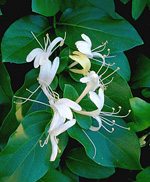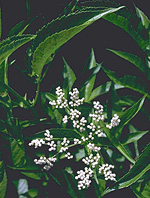 |
This is a medium-sized, almost cosmopolitan, mostly temperate to subtropical family. Leycesteria and Lonicera, two introduced climbers, are sometimes naturalised in high-rainfall areas of the south and east. Sambucus (sometimes placed in the Sambucaceae) has both native and naturalised species, also restricted to temperate climates.
Characteristic features of the family Caprifoliaceae in Australia include: - herbs, soft-wooded shrubs or climbers, with simple, lobed or imparipinnate, opposite leaves
- flowers in panicles, cymes or corymbs; corolla rotate, funnel-shaped or tubular, 5-lobed, actinomorphic or zygomorphic
- stamens at least partly fused to corolla; anthers exsert from the corolla, versatile
- ovary inferior; fruits fleshy, deep red, black or white
Description
Evergreen or deciduous shrubs, or woody or herbaceous vines climbing by twining stems, or perennial terrestrial herbs. Perennating by taproots or crowns. Vegetative reproduction absent or by root suckers. Extra-floral nectaries absent or present on the petiole base. Stem nodes conspicuously swollen or not, internodes solid, spongy or pithy. Internal secretions not obvious. Plants glabrous or with simple, glandular or non-glandular, unicellular hairs. Leaves opposite or very rarely in whorls of 3, cauline if herbs, petiolate. Stipules present or apparently absent, distinct, free or fused along the petiole, often forming extra-floral nectaries, persistent or falling off early; stipellae present or absent. Lamina simple or once compound, imparipinnate, symmetric, ovate, elliptic or oblong; base cuneate, cordate or rounded; margins entire, dentate or serrate, ±flat; venation pinnate, with the midrib conspicuous, and the tertiary venation not reticulate; surfaces not punctate; herbaceous or leathery; distinctive odour absent or foetid. Plants with all the flowers bisexual. Inflorescences terminal or axillary, consisting of panicles, corymbs, thyrses or dichasial cymes. Bracts and bracteoles usually present; membranous or papery. Pollination by insects. Flowers odourless or fragrant; sessile or stalked. Floral disc absent; nectaries absent or present on the carpels. Perianth of 2 dissimilar whorls. Calyx regular; segments fused, with (3–) 4–5 lobes, imbricate or open in bud; calyx cup-shaped or bell-shaped, herbaceous. Corolla regular or irregular; segments free or fused, with (3–) 4–5 petals or lobes, alternating with the calyx lobes, imbricate in bud; corolla wheel-shaped, funnel-shaped or tubular, 2-lipped, with palate, or curved-tubular, white, cream, yellow, pink, magenta, purple or violet, without contrasting markings, or streaked, spotted, etc, membranous; claws absent; lobes ±entire. Fertile stamens (3–) 4 or 5, opposite to the calyx lobes, at least partly fused to the corolla, free of the ovary and style, distinct from each other, all ±equal. Anthers dorsifixed, versatile, opening outwards or inwards by longitudinal slits; 2-celled. Ovary inferior. Carpels 2–5, fused; ovary with 2–5 locules. Style terminal, single and unbranched and the stigma clavate. Ovules 1–numerous per locule, sessile; placentation axile. Fruit a fleshy, indehiscent berry or a drupe; the perianth on the maturing fruit dry and persistent. Disseminule micro-surface ±smooth, white, cream, yellow, red, grey or black, glossy. Seeds 1–numerous per fruit. Aril absent. Cotyledons 2. Embryo straight.
(Note: this description has been generated from the coded data compiled for the key. Any errors in the key data will be reflected in the descriptions.)
A treatment of the family Caprifoliaceae has not yet been published in the Flora of Australia. It will appear in Volume 36.
Australian genera of Caprifoliaceae (as recognised for the Flora of Australia)
† = some species native, others introduced
* = all species introduced
*Leycesteria
*Lonicera
†Sambucus
*Viburnum

|
  |

Lonicera japonica (flowers)
Photo: K.Thiele © ABRS

Sambucus australasica (flowers)
Photo: M.Fagg © M.Fagg

Sambucus australasica (fruits)
Photo: M.Fagg © M.Fagg
|

| |